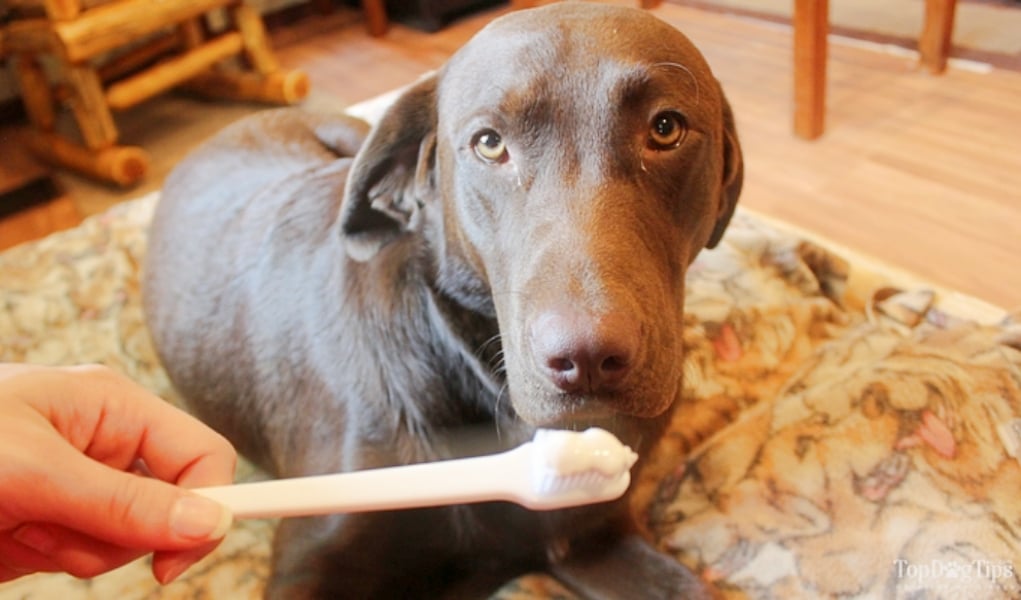How To Clean A Dog’s Teeth Easily – Top Dog Tips
Did you know that cleaning your dog’s teeth regularly is one of the best ways to keep him healthy? Periodontal disease can lead to many other more serious health conditions. Learning how to clean dog’s teeth could add years to your pet’s life.
Most people just assume that all dog’s have bad breath. That’s actually a misconception. Plaque and tartar in the buildup fosters the growth of bacteria. This bacteria is what causes bad breath in dogs.
Bad breath isn’t the main problem associated with poor dental health. Keeping up with your dog’s oral hygiene can aid in his overall health and well-being, going as far as preventing heart problems. Neglecting your dog’s oral health could lead to conditions like:
- destruction to and loss of the gum tissue and bone around the teeth
- fistulas (holes leading from the oral cavity to the nasal passage)
- osteomyelitis (bone infection)
- weakened jaw bone
- bacteria entering the blood stream and having a negative effect on the dog’s heart, liver and kidneys
There are a number of easy ways to keep you dog’s mouth clean. These are all simple tasks that you can do at home, with the exception of professional dental cleanings.
How To Clean Dog’s Teeth
 1. Brush Teeth
1. Brush Teeth
Brushing a dog’s teeth isn’t difficult once you get your pet used to it. It’s similar to brushing your own teeth. The quick steps to this process are:
(1) Get a dog-friendly toothpaste and toothbrush.
(2) Start by brushing one or two teeth at a time, whatever your dog will let you do. The front side of the back teeth and the canine teeth should be your first priority.
(4) Apply slight pressure and move the brush in small circles. Brushing at a 45° angle will allow the toothbrush to clean the gums and teeth properly.
(5) Dog toothpaste does not require rinsing like toothpaste for humans. Once you’ve brushed your pet’s teeth for about 2-3 minutes, you can let the dog lick the remaining toothpaste off his teeth.
If you need more information, I’ve created a video guide with specific instructions for brushing a dog’s teeth. It is recommended that you brush your pup’s teeth daily, but if you don’t have time for that, 3-5 times per week is ideal.
2. Dental Treats and Chews
Most pet owners give their dogs treats once in a while. If you do, choose dental treats which are designed to scrape the dog’s teeth and help prevent plaque and tartar. Likewise, dog dental chews are designed to be both an attractive toy and an effective product for improving dental health.
Dental chews massage a dog’s gums and scrape plaque from his teeth. Giving your dog a dental chew daily will increase salivation, which will decrease the amount of bacteria in his mouth. This may prevent oral diseases and reduce problems with tartar and plaque forming.
Dental treats and chews are designed to help the dog keep his teeth clean and gums healthy. The shape of some top rated dental dog chews provides in-depth and detailed cleaning as your pet gnaws on them, which is why many veterinarians often recommend them over regular treats. However, they should not be used in place of daily brushing.
ALSO: Top 5 Best Dog Dental Treats & Chews
 3. Water Additives & Dental Gels
3. Water Additives & Dental Gels
Commercial water additives can be poured into Fido’s water dish. These products are non-toxic and can be swallowed by your dog. When he drinks, the water additive helps to kill off bacteria and keep the teeth cleaner.
Similar to a doggy toothpaste, dental gels for dogs need to be spread over your pup’s teeth. They’re much easier to use, though, because you simply spread it over the teeth and leave it alone – there’s no brushing involved. The gel works on its own to break up plaque and tartar buildup.
4. Chew Toys
Most pet owners buy chew toys to keep their dog entertained. Chew toys aren’t just great for keeping your pooch busy, they also help keep your dog’s teeth and gums in optimum health.
Chewing on a toy acts like a toothbrush for your dog, scraping away harmful plaque and tartar that can lead to gum disease. Chew toys also scrape bacteria off the teeth and tongue. This helps to reduce bad breath and prevent periodontal disease.
5. Professional Teeth Cleaning
Most veterinarians will recommend having your dog’s teeth professionally cleaned once a year. Your vet will probably want to do the first cleaning when your dog is 6-12 months old. If your dog is already an adult and has never had a professional teeth cleaning, that’s okay.
It’s never too late to start taking care of your dog’s teeth! Your vet will start by examining your dog’s mouth, if he’ll allow it. If not, they’ll do the oral exam once your dog is under anesthesia.
While your dog is sedated, the vet will take x-rays of his mouth to look for broken teeth, abscesses, infection, dead teeth and problems with the roots of the teeth. They will then clean the teeth by scraping away plaque and tartar. They’ll also clean under the gum line, where bacteria is known to build up.
The best way to ensue proper dental health for your pet is to learn how to clean dog’s teeth. Keeping up with your dog’s oral health can add years to his life. It’s a simple and budget-friendly way to care for your pet’s overall health and well-being.
READ NEXT: 11 Science-Based Dog Teeth Care Tips






Мир макияжа: от простого до смелого!
https://girles.kr.ua
eva elfie modeli https://evaelfie.pro/ eva elfie filmleri